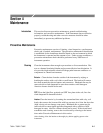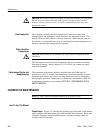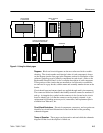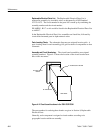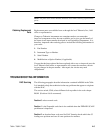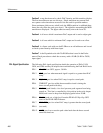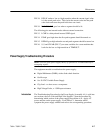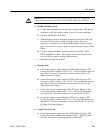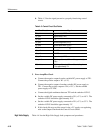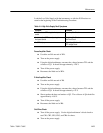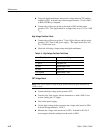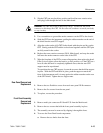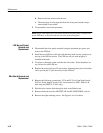
Maintenance
760A / 760D / 760N
4–9
CAUTION. Do not proceed until the the drain of Q9 is near 0 V. Dangerous
voltage potentials are present in the circuit until the capacitors discharge.
2. Rectifier/Switcher Check
a. Use the digital multimeter to measure the voltage between TP2 and the
tab (drain) of Q9. Be sure the voltage is near 0 V before proceeding.
b. Unsolder and lift one end of R102.
c. With the negative lead of the digital multimeter connected to TP2 and
the positive lead connected to the tab of Q9, measure the circuit
resistance. A resistance of less than 20 kW indicates a shorted mosfet
(Q9). If the mosfet is shorted, replace it and perform the Control Circuit
Check.
d. Using the digital multimeter diode test function, test CR21, CR22,
CR23, and CR24 for shorts. Diode replacements must be fast reverse
recovery (300 ns) types to reduce conducted noise.
e. Reconnect the lifted end of R102.
3. Output Check
a. Connect the negative output from the 20 VDC Power Supply to TP1.
Connect the positive output to W4 (+15 V). The circuit should draw less
than 20 mA. Excessive current draw can be caused by CR11 or U2
(High Volts Power Supply).
b. Connect the negative output from the 20 VDC Power Supply to TP1.
Connect the positive output to W2 (+40 V). The circuit should draw less
than 20 mA. Excessive current draw can be caused by CR14 or Q6
(High Volts Power Supply).
c. Connect the positive output from the 20 VDC Power Supply to TP1.
Connect the negative output to W3 (–15 V). The circuit should draw
less than 20 mA. Excessive current draw can be caused by CR12.
d. Connect the negative output from the 5 VDC Power Supply to TP1.
Connect the positive output to W1 (+5 V). The circuit should draw less
than 20 mA. Excessive current draw can be caused by CR13 or Q1 and
Q2 (High Volts Power Supply).
4. Control Circuit Check
a. Connect the negative output from the 20 VDC Power Supply to TP2.
Connect the positive output to the cathode of CR17. Short C47 with a
clip lead. Connect the oscilloscope probe ground to TP2.



